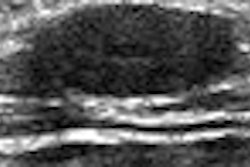Real-time 3D transthoracic echocardiography (RT-3DTTE) yields comparable accuracy to cardiac MRI in assessing left ventricular (LV) volume, mass, and ejection fraction (EF), according to an article published in the February issue of Echocardiography.
While traditional 2DTTE has demonstrated limitations in this application, cardiac MRI has shown promise for accurately defining LV characteristics, according to a research team from the University of Alabama at Birmingham; Cheng Hsin Medical Center in Taipei, Taiwan; and Taipei Veterans General Hospital in Taipei. The cost and availability of MRI make it a largely impractical option for routine clinical use, however (Echocardiography, February 2007, Vol. 24:2, pp. 166-173).
By eliminating geometric assumptions, RT-3DTTE improves on the accuracy of 2DTTE in determining LV volumes and mass; this ability also correlates well with direct MRI measurements, according to the study led by Dr. Xin Qi.
Following up on earlier research that found RT-3DTTE and MRI offered similar value to LV assessment, the researchers sought to extend the comparison of the techniques in a more clinically diverse and slightly larger patient population than previous studies.
The researchers evaluated 58 consecutive patients with various cardiac disorders who had been referred for clinical MRI studies; patient cohort included 40 men and 18 women, with a mean age of 59 years.
Twenty-three were diagnosed with coronary artery disease (CAD), 14 were normal, seven had dilated cardiomyopathy, three had atrial or ventricular septal defects, and three had valvular heart disease. Exclusion criteria included atrial fibrillation, pacemaker or defibrillator implantation, claustrophobia, contraindications to MRI, cardiac arrhythmias, left bundle-branch block, and prior sternotomy.
On the same day, all patients received cardiac MRI using a Magnetom Symphony 1.5-tesla whole-body scanner (Siemens Medical Solutions, Malvern, PA) and RT-3DTTE, which was performed using an iE33 scanner (Philips Medical Systems, Andover, MA) with a 4X matrix array transducer. The 3D datasets were analyzed offline using version 5.2 of Echoview software (TomTec Imaging Systems, Unterschleissheim, Germany).
The group also assessed interobserver variability by having a second observer, blinded to the values obtained by the first observer and MRI, analyze a randomly selected subgroup of 20 patients a second time. Intraobserver variability was also calculated in a similar fashion, with the same observer analyzing a randomly selected subgroup of 20 patients after two weeks.
"Overall the high correlation coefficients between RT-3DTTE and MRI support the reliability we sought to find in this study," the authors wrote.
For LV end-diastolic volume (EDV), the study team found a correlation coefficient between the modalities of r = 0.92 and standard error of the estimate (SEE) of 21 mL. Bland-Altman analysis revealed a bias of -22 mL and standard deviation (SD) of 23 mL.
In end-systolic volume (ESV), the modalities showed a correlation coefficient of r = 0.94 and SEE of 16 mL. Bland-Altman analysis found a bias of -15 mL and SD of 20 mL. EF comparison had a correlation coefficient of r = 0.92, SEE of 10%, and Bland-Altman bias of + 5% with SD of 10%.
All three volume parameters showed high correlations, the authors noted.
"Negative bias for both EDV and ESV showed an underestimation for 3DTTE compared with the MRI modality used in our study," the authors wrote. "Notably, in evaluating these parameters, our study population contained three individuals with markedly dilated ventricles associated with the clinical diagnosis of dilated cardiomyopathy. Inclusion or exclusion of the largest of these did not significantly affect correlations between RT-3DTTE and MRI for LV EDV and LV ESV."
A high correlation was found between RT-3DTTE and MRI for evaluating LV mass, with r = 0.933 and SEE = 18. Bland-Altman analysis showed a bias of +8.14 with SD of 17.6%. Mass index comparisons found correlations of r = 0.916, SEE of 10.30, and Bland-Altman analysis bias of +5.08 with SD of 10%, according to the study team.
As for interobserver variability, the study team found no significant difference between the two readers. Intraobserver variability showed significant correlation with EDV r = 0.947 and SEE 11.84 mL; ESV r = 0.982 and SEE 5.95 mL; and EF r = 0.948 and SEE 3.55%, according to the researchers. They also found limited variability for LV mass, with correlation of r = 0.952 and SEE of 11.34.
The research further validates previous studies and expands the application of RT-3DTTE to a larger and more diverse clinic population, according to the researchers.
"We feel that there is an important need for continued validation studies on larger and more diverse patient populations as the one we present to establish the use of RT-3DTTE in clinical cardiology," the authors concluded.
By Erik L. Ridley
AuntMinnie.com staff writer
February 28, 2007
Related Reading
Bosentan improves myocardial function in systemic sclerosis patients, January 18, 2007
Patent foramen ovale linked to high-altitude pulmonary edema, December 27, 2006
Ultrasound can identify some patients with subclinical cardiac risk, December 20, 2006
Top cardiac imaging choices to change, October 10, 2006
Spatiotemporal image correlation, TUI show promise in fetal echocardiography, August 8, 2006
Copyright © 2007 AuntMinnie.com



















